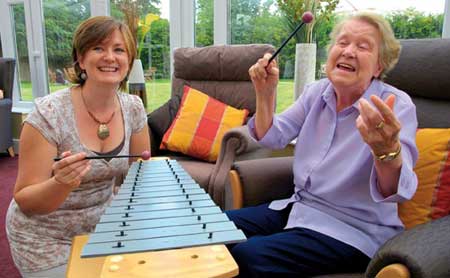Okay, so I want to share a little bit more about how my understanding of music therapy has changed since I first semester. And obviously, my understanding is going to keep changing as I continue to learn more.
Music therapy isn't a good fit for everyone. But - for some people, it can draw them out and allow them to interact with "our" world.
Here's a video showing an older man reacting to music. I love how you can see his eyes light up. He sits up straighter, he becomes active, his speech is clear.. If you want to skip the back story, you can start watching at 2:00. If nothing else, watch 5:19-5:45 to hear him talk about music.
According to Kenneth E. Bruscia, a big name in Music Therapy, says that it involves six key concepts.
The first is that music therapy is a Systematic Process. This means that music therapy is very intentional. The first thing a music therapist does with a new client is an assessment and creating goals and objectives. Every session is intentional in helping the client to meet these goals.
Music Therapy includes the Therapist and Client. This seems kind of obvious, but therapy is a two way street. The therapist can only help the client as much as the client wants to be helped.
Again, this is kind of obvious. But, Health Promotion is the core of Music Therapy. Music Therapy looks at the person as a whole, and focuses on all aspects of health.
For example,
physically: beating a drum to increase ease or range of motion
mentally: learning and retaining information through educational songs
socially: encouraging play and interaction with peers
emotionally: helping to heal deep emotional scars from a rough childhood
spiritually: helping to deal with the hard questions and unknown answers about life after death in a hospice.
Perhaps the most obvious is Music. Some techniques that we use to accomplish our goals are improvising, singing, songwriting, lyric analysis, playing instruments and movement-to-music. Again, this is all very intentional.
As with all other forms of therapy, there is a Therapeutic Relationship between music, the therapist and client. This means that the client and therapist are working together towards a common goal.
Finally, Music Therapy deals with Dynamic Forces of Change. Every session is documented and analyzed. It is the therapist's job to constantly be assessing the sessions to make sure that the client is being helped in the best way. Actually, I have a class right now that is all about this! It's very overwhelming, but I know that it will all make sense ... eventually! :)
In short, Music Therapy is so much more than just singing songs to make people feel better :)
I hope you weren't too bored by this post ... I'm sure I have a higher tolerance for the nitty - gritty stuff!
Thanks for sticking with me!
Amanda




No comments:
Post a Comment